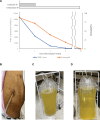Case report: Peritonitis caused by Pantoea agglomerans from pet dog exposure in peritoneal dialysis
- PMID: 39535587
- PMCID: PMC11556950
- DOI: 10.1097/MD.0000000000040247
Case report: Peritonitis caused by Pantoea agglomerans from pet dog exposure in peritoneal dialysis
Abstract
Rationale: Peritonitis caused by Pantoea agglomerans is a rare occurrence in patients undergoing peritoneal dialysis. Cases potentially linked to pet dogs are even rarer, and there is limited literature available.
Patient concerns: A patient undergoing peritoneal dialysis presented with symptoms of peritonitis, including abdominal pain and cloudy dialysis fluid.
Diagnoses: Microbiological analysis identified P agglomerans as the causative organism.
Interventions: The patient was treated with targeted antibiotic therapy and showed a positive response.
Outcomes: During a subsequent medical interview, it was revealed that the patient had close contact with their pet dog, raising the possibility that the infection may have been associated with this exposure.
Lessons: This case highlights the importance of considering zoonotic transmission as a potential source of infection in peritoneal dialysis patients, particularly when there is close contact with pets. Healthcare providers should educate patients about the potential risks posed by pets and implement preventive strategies to mitigate such risks.
Copyright © 2024 the Author(s). Published by Wolters Kluwer Health, Inc.
Conflict of interest statement
The authors have no conflicts of interest to disclose.
Figures

Similar articles
-
An unusual cause of peritonitis in peritoneal dialysis patients: Pantoea agglomerans.J Infect Dev Ctries. 2014 Jul 14;8(7):919-22. doi: 10.3855/jidc.3785. J Infect Dev Ctries. 2014. PMID: 25022305
-
Pantoea dispersa peritoneal dialysis catheter-related infection.BMJ Case Rep. 2024 Jun 6;17(6):e260878. doi: 10.1136/bcr-2024-260878. BMJ Case Rep. 2024. PMID: 38844354
-
Unusual causes of peritonitis in a peritoneal dialysis patient: Alcaligenes faecalis and Pantoea agglomerans.Ann Clin Microbiol Antimicrob. 2011 Apr 10;10:12. doi: 10.1186/1476-0711-10-12. Ann Clin Microbiol Antimicrob. 2011. PMID: 21477370 Free PMC article.
-
Peritonitis Secondary to Uncommon Gram-Negative Coccobacillus Transmitted From a Cat in a Patient on Peritoneal Dialysis.J Investig Med High Impact Case Rep. 2019 Jan-Dec;7:2324709619895165. doi: 10.1177/2324709619895165. J Investig Med High Impact Case Rep. 2019. PMID: 31838876 Free PMC article. Review.
-
Pet-related Pasteurella multocida induced peritonitis in peritoneal dialysis: a case report and review of the literatures.BMC Nephrol. 2020 Mar 19;21(1):102. doi: 10.1186/s12882-020-01765-1. BMC Nephrol. 2020. PMID: 32192435 Free PMC article. Review.
References
-
- Lim PS, Chen SL, Tsai CY, Pai MA. Pantoea peritonitis in a patient receiving chronic ambulatory peritoneal dialysis. Nephrology (Carlton). 2006;11:97–9. - PubMed
-
- Habhab W, Blake PG. Pantoea peritonitis: not just a “thorny” problem. Perit Dial Int. 2008;28:430. - PubMed
-
- Antony SJ, Oglesby KA. Peritonitis associated with Pasteurella multocida in peritoneal dialysis patients – case report and review of the literature. Clin Nephrol. 2007;68:52–6. - PubMed
Publication types
MeSH terms
Substances
Grants and funding
LinkOut - more resources
Full Text Sources

